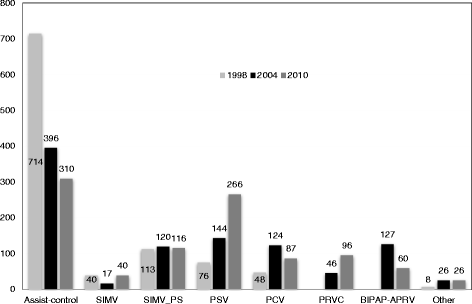Management and outcome of mechanically ventilated patients after cardiac arrest
- PMID: 25953483
- PMCID: PMC4457998
- DOI: 10.1186/s13054-015-0922-9
Management and outcome of mechanically ventilated patients after cardiac arrest
Abstract
Introduction: The aim of this study was to describe and compare the changes in ventilator management and complications over time, as well as variables associated with 28-day hospital mortality in patients receiving mechanical ventilation (MV) after cardiac arrest.
Methods: We performed a secondary analysis of three prospective, observational multicenter studies conducted in 1998, 2004 and 2010 in 927 ICUs from 40 countries. We screened 18,302 patients receiving MV for more than 12 hours during a one-month-period. We included 812 patients receiving MV after cardiac arrest. We collected data on demographics, daily ventilator settings, complications during ventilation and outcomes. Multivariate logistic regression analysis was performed to calculate odds ratios, determining which variables within 24 hours of hospital admission were associated with 28-day hospital mortality and occurrence of acute respiratory distress syndrome (ARDS) and pneumonia acquired during ICU stay at 48 hours after admission.
Results: Among 812 patients, 100 were included from 1998, 239 from 2004 and 473 from 2010. Ventilatory management changed over time, with decreased tidal volumes (VT) (1998: mean 8.9 (standard deviation (SD) 2) ml/kg actual body weight (ABW), 2010: 6.7 (SD 2) ml/kg ABW; 2004: 9 (SD 2.3) ml/kg predicted body weight (PBW), 2010: 7.95 (SD 1.7) ml/kg PBW) and increased positive end-expiratory pressure (PEEP) (1998: mean 3.5 (SD 3), 2010: 6.5 (SD 3); P <0.001). Patients included from 2010 had more sepsis, cardiovascular dysfunction and neurological failure, but 28-day hospital mortality was similar over time (52% in 1998, 57% in 2004 and 52% in 2010). Variables independently associated with 28-day hospital mortality were: older age, PaO2 <60 mmHg, cardiovascular dysfunction and less use of sedative agents. Higher VT, and plateau pressure with lower PEEP were associated with occurrence of ARDS and pneumonia acquired during ICU stay.
Conclusions: Protective mechanical ventilation with lower VT and higher PEEP is more commonly used after cardiac arrest. The incidence of pulmonary complications decreased, while other non-respiratory organ failures increased with time. The application of protective mechanical ventilation and the prevention of single and multiple organ failure may be considered to improve outcome in patients after cardiac arrest.
Figures

References
-
- Kim YM, Yim HW, Jeong SH, Klem ML, Callaway CW. Does therapeutic hypothermia benefit adult cardiac arrest patients presenting with non-shockable initial rhythms?: a systematic review and meta-analysis of randomized and non-randomized studies. Resuscitation. 2012;83:188–96. doi: 10.1016/j.resuscitation.2011.07.031. - DOI - PubMed
-
- Peberdy MA, Callaway CW, Neumar RW, Geocadin RG, Zimmerman JL, Donnino M, et al. Part 9: post-cardiac arrest care: 2010 American Heart Association Guidelines for Cardiopulmonary Resuscitation and Emergency Cardiovascular Care. Circulation. 2010;122:S768–86. doi: 10.1161/CIRCULATIONAHA.110.971002. - DOI - PubMed
-
- Nielsen N, Wetterslev J, Cronberg T, Erlinge D, Gasche Y, Hassager C, et al. Targeted temperature management at 33 degrees C versus 36 degrees C after cardiac arrest. N Engl J Med. 2013:2197–206. doi:10.1056/NEJMoa1310519 - PubMed
-
- Mentzelopoulos SD, Malachias S, Chamos C, Konstantopoulos D, Ntaidou T, Papastylianou A, et al. Vasopressin, steroids, and epinephrine and neurologically favorable survival after in-hospital cardiac arrest: a randomized clinical trial. JAMA. 2013;310:270–9. doi: 10.1001/jama.2013.7832. - DOI - PubMed
Publication types
MeSH terms
Substances
LinkOut - more resources
Full Text Sources
Other Literature Sources
Medical

